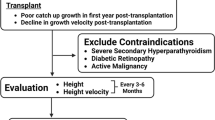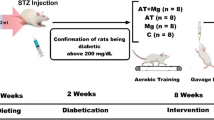Abstract
Malnutrition is prevalent in patients with end-stage renal disease (ESRD). Elevated serum leptin levels were thought to contribute to the anorexia and poor nutrition in renal failure. However, studies of the relationship between nutritional status and leptin concentration in chronic renal failure have yielded conflicting results. Plasma insulin-like growth factor I (IGF-I) level has been used as an indicator of nutritional status in patients with renal failure. The relationship between leptin and IGF-I is controversial. The present study was conducted with the aim of assessing the relationship between nutritional status, hyperleptinemia, and serum IGF-I. Seventeen ESRD patients (8 male, 9 female), aged 8–18 years (mean 15.3±3.3 years) and undergoing standard hemodialysis for 58.8±23.1 months were enrolled. Nine age-matched healthy children served as controls. In all patients, energy and protein intakes were 40–70 kcal/kg per day and 1–1.54 g/kg per day, respectively. Predialysis serum leptin and IGF-I levels were measured by radioimmunoassay. Body mass index was decreased in 13 (76%) patients. Triceps skinfold thickness (TST) was reduced (below the 5th percentile) in 7 (41%), whereas mid arm circumference and mid arm muscle circumference were reduced in 14 (82.5%) and 13 (76.5%), respectively. The median serum leptin level was significantly higher in patients than in controls [13.7 interquartile range (IQR) 30.50 pg/ml vs. 6.50 IQR 8.65 pg/ml, P=0.01]. The median serum IGF-I level was lower in the patients (205.1 ng/ml IQR 194.4 ng/l) than controls (418.0 ng/l IQR 310.5 ng/ml) (P=0.01). IGF-I levels were more decreased in patients with severe malnutrition, defined according to TST (145.0 ng/ml IQR 125.5 ng/l) than patients without malnutrition (301.2 ng/l IQR 218.8 ng/ml) (P=0.03) and healthy children (P=0.002). Although statistically not significant, IGF-I levels tended to be decreased, while leptin levels were increased. The median plasma insulin concentration was 15 μU/ml (1.63–45.80) and did not correlate with leptin and IGF-I levels. In conclusion, the results of this study confirm the presence of high circulating plasma leptin levels, which may be one of the many factors involved in the pathogenesis of the malnutrition in children on hemodialysis.

Similar content being viewed by others
References
Bergström J (1995) Why are dialysis patients malnourished? Am J Kidney Dis 26:229–241
Zhang Y, Proenca R, Maffei M, Barone M, Leopold L, Friedman CM (1994) Positional cloning of the mouse obese gene and its human homologue. Nature 372:425–432
Daschner M, Tönshoff B, Blum WF, Englaro P, Wingen AM, Schaefer F, Wühl E, Rascher W, Mehls O (1998) Inappropriate elevation of serum leptin levels in children with chronic renal failure. J Am Soc Nephrol 9:1074–1079
Young GA, Woodrow G, Kendall S, Oldroyd B, Turney JH, Brown-John AM, Smith MA (1997) Increased plasma leptin/fat ratio in patient with chronic renal failure: a cause of malnutrition? Nephrol Dial Transplant 12:2318–2323
Seeley RJ, Yagaloff KA, Fisher SL, Burn P, Thiele TE, Van Duk G, Baskın DG, Schwortz MW (1997) Melanocortin receptor in leptin effects. Nature 27:349
Sharma K, Considine RV, Beckie M, Dunn SR, Weisberg LS, Kurnik BRC, Kurnik PB, O’Connor J, Sinha M, Caro CF (1997) Plasma leptin is partly cleared by the kidney and is elevated in hemodialysis patients. Kidney Int 51:1980–1985
Heimbürger O, Lönnqvist F, Danielsson A, Nordenström J, Stenvinkel P (1997) Serum immunoreactive leptin concentrations and its relation to the body fat content in chronic renal failure. J Am Soc Nephrol 8:1423–1430
Stenvinkel P, Heimbürger O, Lönnqvist F (1997) Serum leptin concentrations correlate to plasma insulin concentrations independent of body fat content in chronic renal failure. Nephrol Dial Transplant 12:1321–1325
Jacob V, Le Carpentier JE, Salzano S, Naylor V, Wild G, Brown CB, Nahas AM el (1990) IGF-1, a marker of undernutrition in the hemodialysis population. Am J Clin Nutr 52:39–44
Sanaka T, Shinobe M, Ando M, Hizuka N, Kawaguchi H, Nihei H (1994) IGF-1 as an early indicator of malnutrition in patients with end stage renal disease. Nephron 67:73–81
Besbas N, Özdemir S, Saatçi Ü, Coskun T, Ozen S, Topaloglu R, Bakkaloglu A, El Nahas AM (1998) Nutritional assessment of children on haemodialysis: value of IGF-1, TNF-α and IL-1 β. Nephrol Dial Transplant 13:1484–1488
Soliman AT, Hassan AHI, Aref MK, Hintz RL, Rosenfeld RG, Rogol AD (1986) Serum insulin like growth factors I and II concentrations and growth hormone and insulin responses to arginine infusion in children with protein energy malnutrition before and after nutritional rehabilitation. Pediatr Res 11:1122–1130
Isley WL, Underwood LE, Clemmomns DR (1983) Dietary components that regulate serum somatomedin-C concentrations in humans. J Clin Invest 71:175–182
Fontan MP, Rodriguez-Carmona A, Cordido F, Garcia-Buela J (1999) Hyperleptinemia in uremic patients undergoing conservative management, peritoneal dialysis, and hemodialysis: a comparative analysis. Am J Kidney Dis 34:824–831
Fouque D, Juillard L, Lasne Y, Tabakian A, Laville M, Joly MO, Laville M (1998) Acute leptin regulation in end stage renal failure: the role of growth hormone and IGF-I. Kidney Int 54:932–937
FAQ/WHO Expert Committee (1987) Energy and protein requirement. Report of a Joint FAQ/WHO expert committee 52:40–72
Frisancho AR (1981) New norms of upper limb fat and muscle areas for assessment of nutritional status. Am J Clin Nutr 34:2540–2545
Fouque D, Peng S, Kopple JD (1995) Pharmacokinetics of recombinant human insulin like growth factor-1 in dialysis patients. Kidney Int 47:869–875
Özön A, Kandemir N, Oğuz H, Yordam N (1995) Evaluation of IGF-1 and IGFBP-3 levels in Turkish children at various ages and children with constitutionally delayed growth (abstract). Abstracts of International Symposium on Developmental Issues In Pediatric Endocrinology, Hamburg, p 4
Pelleymounter MA, Cullen MJ, Baker MB, Hecht R, Winters D, Boone T, Collins (1995) Effects of the obese gene product on body weight regulation in ob/ob mice. Science 269:540–543
Wiecek A, Kokot F, Chudek J, Adamczak M (2002) The adipose tissue—a novel endocrine organ of interest to the nephrologist. Nephrol Dial Transplant 17:191–195
Emilsson V, Liu Y-L, Cawthorne MA, Morton NM, Davenport M (1997) Expression of the functional leptin receptor m-RNA in pancreatic islets and direct inhibitory action of leptin on insulin secretion. Diabetes 46:313–316
Dagogo-Jack S, Franklin SC, Vijayan A, Liu J, Askari H, Miller SB (1998) Recombinant human insulin like growth factor-I (IGF-I) therapy decreases plasma leptin concentration in patients with chronic renal insufficiency. Int J Obes Relat Metab Disord 22:1110–1115
Bolinder J, Lindblad A, Engfeldt P, Arner P (1987) Studies of acute effects of insulin like growth factors I and II in human fat cells. J Clin Endocrinol Metab 65:732–737
Iglesias P, Diez JJ, Fernandez-Reyes MJ, Bajo MA, Aguilera A, Mendez J, Codoce Selgas R (2002) Effects of short-term recombinant human growth hormone therapy on plasma leptin concentrations in dialysis patients. Nephrol Dial Transplant 17:260–264
Nordfors L, Lönqvist F, Heimbürger O, Danielsson A, Schalling M, Stenvinkel P (1998) Low leptin gene expression and hyperleptinemia in chronic renal failure. Kidney Int 54:1267–1275
Author information
Authors and Affiliations
Corresponding author
Rights and permissions
About this article
Cite this article
Besbas, N., Ozaltin, F., Coşkun, T. et al. Relationship of leptin and insulin-like growth factor I to nutritional status in hemodialyzed children. Pediatr Nephrol 18, 1255–1259 (2003). https://doi.org/10.1007/s00467-003-1264-4
Received:
Revised:
Accepted:
Published:
Issue Date:
DOI: https://doi.org/10.1007/s00467-003-1264-4




